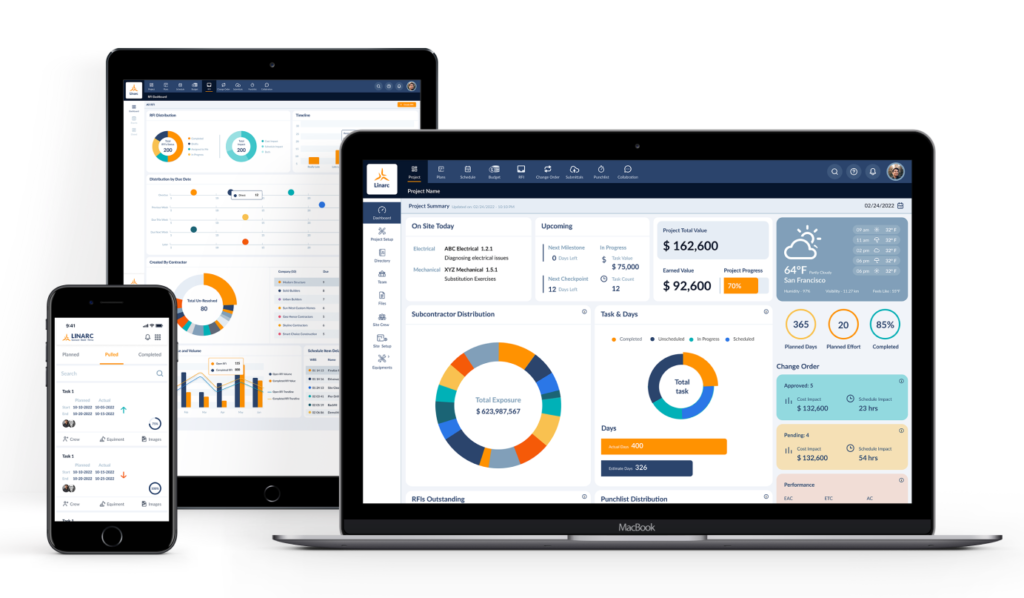5 Tips for Better Construction Document Management

Without a solid document management strategy, the volume of documents you need to track can be overwhelming. These 5 tips can help.
From blueprints, permits, and submittals to RFIs, change orders, and pay requests, construction documents play a critical role in communicating vital information between project stakeholders.
But without a solid document management strategy, the sheer volume of documents you need to track and manage can be overwhelming.
That’s why it’s essential to have a well-structured construction document management system to help keep everything organized and flowing smoothly.
Here are five tips for creating a document management strategy to make information easy for stakeholders to access and act upon.
Here’s what we cover:
- 1. Start with an organized hierarchy.
- 2. Use a centralized document management system.
- 3. Implement version control procedures.
- 4. Activate automation and document management workflow tools.
- 5. Ongoing training for project team members.
- Why use software to store construction documents?
- What are some of the features of document management software?
1. Start with an organized hierarchy.
One of the keys to successful document management is starting with an organized hierarchy.
Categorizing your documents into folders and subfolders based on their purpose type makes it easy for your project teams to access the information they need when they need it most.
For example, you might have separate folders covering the following primary project document categories:
Project Initiation
- Project Charter
- Owner’s Business Case
- Feasibility Reports
- Project Scope Statement
- Stakeholder Register
- Conceptual Design and Budget
- Project Management Plan
These essential documents are critical to the project’s success, establishing the foundation for effective project planning, management, and execution.
Pre-Construction
A well-executed preconstruction phase can save time and money in the long run by identifying potential issues and risks before construction begins.
During the preconstruction phase, project teams rely on several key documents to ensure the project is effectively planned and prepared for construction.
These document categories include:
- Contract Documents
- Prime and Subcontractor agreements
- Permitting and Regulatory Approvals
- Project Management Plan
- Project Team Charter
- Risk Management and Safety Plan
- Change Management Plan
- Quality Control Plan
- Communication Plan
- Construction Design Drawings
- Specifications
- Submittals and
- Bid Documents
- Procurement Plan
- RFPs, RFQs, and RFIs
- Project Budget
- Master Schedule
Project Execution
The project execution phase is a dynamic and ever-changing process.
During this phase, RFIs and submittal documents continue to flow, and ensuring that these documents are properly managed and tracked is vital.
The project delivery team will build on many of the same categories established during preconstruction:
- Construction Design Drawings
- Specifications
- Submittals and
- Bid Documents
- Procurement Planning and Management
- RFPs,
- RFQs, and
- RFIs
- Project Budget
- Change orders
- Construction Change Directives
- Pay requests
- Cost accounting and reporting
- Master Schedule
As the project progresses, change order requests, construction change directives, change orders, and payment requests multiply, creating a need for an intuitive, automated document management system.
A practical document management system enables project teams to access the latest documents, track changes, and communicate effectively across different teams and workgroups.
It is essential to have a flexible and adaptable document management system to ensure that project documentation is properly managed, organized, and accessible throughout the project’s lifecycle.
Project Closeout
During project closeout and commissioning, the owner relies on the project delivery team to supply several vital documents.
These documents include the following:
- Punch List Log
- As-Built Drawings
- Operation and Maintenance Manuals
- Training Documentation
- Final Inspection Reports
- Final Payment Requests
- Commissioning Reports and Certifications
These essential documents are critical to successful project closeout and commissioning and to ensure the project is turned over to the owner promptly and efficiently.
They prove that the project is complete, constructed to the owner’s satisfaction, and the asset is ready for occupancy or use.
By ensuring that all required documents are correctly prepared and submitted, project teams can reduce the likelihood of delays, disputes, and legal issues after project completion.

2. Use a centralized document management system.
Utilizing a centralized document management system is an absolute must for efficient construction document management.
Secure, centralized document storage makes it easy for stakeholders to find what they need without searching multiple folders or emails.
In addition, a centralized system can provide real-time access to important documents from anywhere, allowing team members to stay informed and up-to-date on the latest changes and progress.
Implementing a centralized system will streamline your document management process and save valuable time and resources in the long run.
3. Implement version control procedures.
Version control procedures are crucial for construction document management, especially when different team members are working on the same project.
Without version control, you risk creating confusion and errors by having multiple versions of the same document floating around.
One way to implement version control is to assign a unique identifier to each document version, such as a serial number or date stamp.
You can use software tools like Dropbox or Google Drive, which have built-in version control features. But your best bet is to use an integrated project management system like Linarc.
Linarc ensures your key stakeholders have access to the latest version of vital documents and avoids any costly mistakes caused by work crews operating from old, outdated information.
4. Activate automation and document management workflow tools.
Integrating automation and workflow tools into your processes is one of the best ways to maximize your productivity, and Linarc’s document management system is the best in the business.
These tools can help you automate tasks such as sending notifications, updating documents, and sharing files among team members. Implementing these tools can save time and reduce errors, ultimately leading to a more efficient construction project.
5. Ongoing training for project team members.
Train all project team members on the importance of document management and establish clear protocols for document creation, storage, and sharing.
Encourage team members to follow best practices and report any issues or concerns related to document management. Ensure team members understand why document management is essential and they take full advantage of the tools available to them.
By continuously improving your document management process and the people you rely on to use it effectively, you’ll save time, resources, and costs while delivering high-quality projects on time.
Why use software to store construction documents?
Managing construction documents is a vital part of any successful building project.
Keeping all the drawings, change orders, RFIs, and other essential paperwork current and accessible to all team members reduces misunderstandings and keeps everyone on track.
With so many different people collaborating on any project, you want to ensure that your project team always has the latest version of plans, specifications, and correspondence.
Cloud-based software programs like Linarc ensure that all your stakeholders have access to the same accurate information leading to more efficient communication, less rework, and improved decision-making throughout the construction process.
What are some of the features of document management software?
Many document management software options are available on the market, so it’s essential to choose one that meets the unique needs of your construction project.
Here are some key features to look for in construction document management software:
- Cloud-based storage: Look for software that provides secure, cloud-based storage of project documents. Cloud storage makes it easier for project team members to access and collaborate on documents from anywhere with an internet connection.
- File types supported: It’s essential to have a system that can handle a wide range of file types. Typical file types include CAD (.dwg) files for design drawings, word processing documents (.doc) for contracts and correspondence, spreadsheets (.xlsx) for budgets and schedules, as well as PDF files for sharing finalized documents. By implementing a document management system that supports all necessary file types, you can ensure that your project runs smoothly and that everyone involved can access the required information.
- Version control: Ensure that the software provides robust version control capabilities, allowing team members to track changes and revisions to project documents easily.
- Customizable workflows: Choose software that allows customizable workflows to support your project’s document management needs. Linarc’s project management platform includes features such as document routing and approvals, task assignments, and notifications for ease of use and efficiency.
- Mobile access: Look for software with mobile access capabilities, allowing team members to access and collaborate on project documents using their smartphones or tablets.
- Collaboration features: Choose software that includes collaboration features such as chat, commenting, annotation, markup and file sharing. This allows project team members to work together in real-time, increasing productivity and reducing errors.
- Permission-based access: Robust permission and access control enable unlimited users to collaborate on a secure platform, giving them only the required level of access without compromising sensitive data. Permission-based access helps to increase overall security, and efficiency while minimizing risks for the entire project team.
- Integrations: Consider software that can integrate with other tools and applications commonly used in the construction industry, such as estimating software, ERP software, and BIM tools.
By selecting document management software that includes these key features, construction project teams can streamline their document workflows, improve communication and collaboration, and deliver projects more efficiently and effectively.
Managing construction documents can be a challenging task without the right tools.
Linar’c cloud-based document management systems can provide a solution that allows for easy access to essential project documents, including drawings, financial information such as budgets and costs, RFIs, submittals, and more.
In addition, with this system, team members can access critical data from anywhere at any time on mobile devices like smartphones and tablets – even from the field!
Get a free custom demonstration today!
There’s a better way to manage your vital project information and make it accessible to everyone, everywhere, and in real-time.
Linarc is an intelligent, intuitive, easy-to-use tool that simplifies the complexity of today’s projects.
Get a quick and easy demonstration of the Linarc construction management system today.
Connect – Build – Thrive with Linarc




